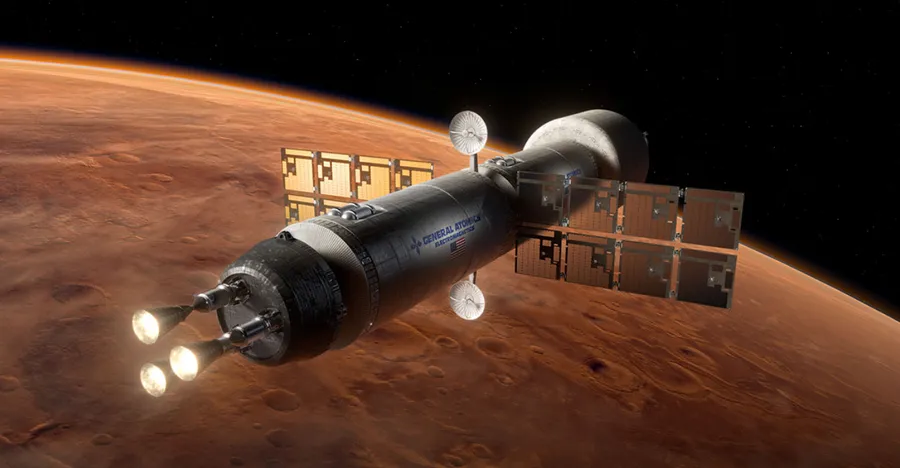
In-Space Nuclear Propulsion, The Current Outlook With a Historical Overview
by Elendacil
In-Space Nuclear Thermal Propulsion (NTP) has hovered at the border of human capability for almost 70 years. Pairing a simpler engine cycle and greater efficiencies than standard chemical rocket engines, NTP has been envisioned as the propulsion system of choice for applications ranging from cis-lunar (the region between the Moon and Earth) and Mars transit, to other in-space ambitions such as exploration and resource extraction in the inner asteroid belt. Conventional chemical propulsion is bulky and volatile, necessitating a larger vehicle to transport the fuel and oxidizer. NTP has the advantage of being a monopropellant engine, ideally using hydrogen (H2), an abundant resource and potential source of fuel anywhere there is ice, i.e. the Moon or Mars. In addition, the engine’s nuclear reactor has the potential to double as a power source. This increase of the engine’s utility density in an environment where mass and space have such a high premium is ideal. So why are NTP engines not being used if they have so many advantages over conventional propulsion systems? To put it simply, nuclear rocket propulsion has had a complicated development history that continues to this day. While the need and demand for NTP systems persists, they remain as of yet un-realized capability in the push to expand human capabilities beyond Earth.
In 1953 director of the Naval Reactors Branch of the Atomic Energy Commission (ACE), Rear Admiral Rickover penned his famous “Paper Reactor Memo.” At the time, Admiral Rickover was leading the S1W reactor development for the Nautilus, an immensely ambitious project to miniaturize a nuclear power plant into the confines of a submarine. This program was ultimately a success and in 1954 the first nuclear powered submarine, dubbed the USS Nautilus, was launched and commissioned. In his memo Rickover addresses a difficult dilemma that he articulates as follows:
" Important decisions relative to the future development of atomic power must frequently be made by people who do not necessarily have an intimate knowledge of the technical aspects of reactors. These people are, nonetheless, interested in what a reactor plant will do, how much it will cost, how long it will take to build, and how long and how well it will operate. When they attempt to learn these things, they become aware of confusion existing in the reactor business. There appears to be unresolved conflict on almost every issue that arises." [1]
One of the great sources of programmatic and systemic dysfunction is that the onus for the direction and funding of many advanced programs rests on politicians who have little or no knowledge of said program. This is a problem with no direct solution as it is infeasible for every politician to be a subject matter expert on every program the government could fund. Rickover's memo focused on addressing the government’s failure to distinguish and understand the academic and practical merits of a program [1].
Nuclear Rocket propulsion development has been plagued by this dynamic from inception to the present. With strong initiatives in the United States and other nations to develop and implement in-space NTP currently ongoing, a more detailed explanation of what is NTP, thrust, and specific impulse (ISP) is warranted.
What is Thrust, What is ISP
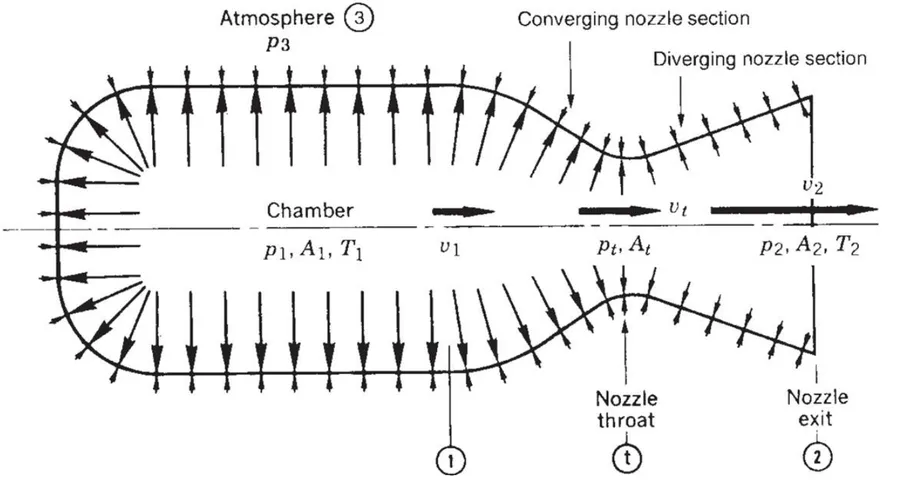
Figure 3: Diagram showing the pressures acting inside the main combustion chamber and nozzle of a rocket engine.
Two important concepts for the discussion of rocket propulsion systems are thrust and specific impulse. The first is a term used in common parlance but in rocket propulsion the meaning is specific and bounded. Thrust, using its technical rather than colloquial meaning, in a rocket engine is generated through the principle of the conservation of Momentum. Every action must have an equal and opposite reaction and the expulsion of a propellant particle at high velocities from a rocket necessitates an equal and opposite reaction by the body of the rocket. This reaction force (thrust) of a rocket engine can be represented by the following equation:
Where ṁ is the mass flow rate (the mass of the propellant exiting per second) of the propellant (the mass of the propellant exiting per second) multiplied by v22, the square of the velocity of the existing propellant. p2 and p3 are the pressure at the exit and ambient respectively and A2 is the cross-sectional area of the exit. So the thrust generated by a rocket engine is the combination of the reaction force to the propellant being accelerated and the pressure differential between the nozzle outlet pressure and the ambient pressure.
Specific impulse (ISP) is a way to gauge rocket engine performance almost like miles per gallon for cars. It is a metric for how much thrust you get out of a unit of propellant. It is one of the most standard and useful ways to compare rocket engine performance across the same application. Impulse is the integral of force over a specified period of time:
So for example a rocket engine thrusting at 500 lbf (force pounds, a unit of force that equals the gravitational force exerted on a one-pound mass at standard Earth gravity) for 10 seconds would have a total impulse of 5000 lbf•s. Specific impulse takes the total impulse of the rocket and, using the weight of the fuel used during the period of time the total impulse was taken, communicates an impulse per weight of propellant (weight at the average acceleration of gravity at Earth's surface) that is used to measure engine efficiency.
So using our example above our rocket engine used 10 lbm (pounds-mass) of propellant over the 10 second burn. Dividing the total impulse by the weight we are left with a specific impulse of 500 s for our hypothetical NTP rocket engine. For reference the specific impulse of the RS-25 space shuttle main engines (the engines used to get the Hubble telescope to orbit) had a specific impulse of 366-452 s depending on the conditions. NTP rocket engines are capable of reaching much higher specific impulses than conventional chemical rockets, with most mission goals being around 900 s of ISP.
What is Nuclear Thermal Propulsion?
NTP is the use of a nuclear reactor to heat a propellant to create thrust in a rocket engine. This differs from a conventional rocket engine that uses the chemical reaction between a fuel and an oxidizer to create thrust in an engine. Going forward all discussion of performance, use, and requirements are for in-space applications only. Getting from the surface of Earth to orbit is a very different propulsion problem than in-space applications in the realm of cost benefit analysis for engine efficiency, propellent cost, thrust, and weight.
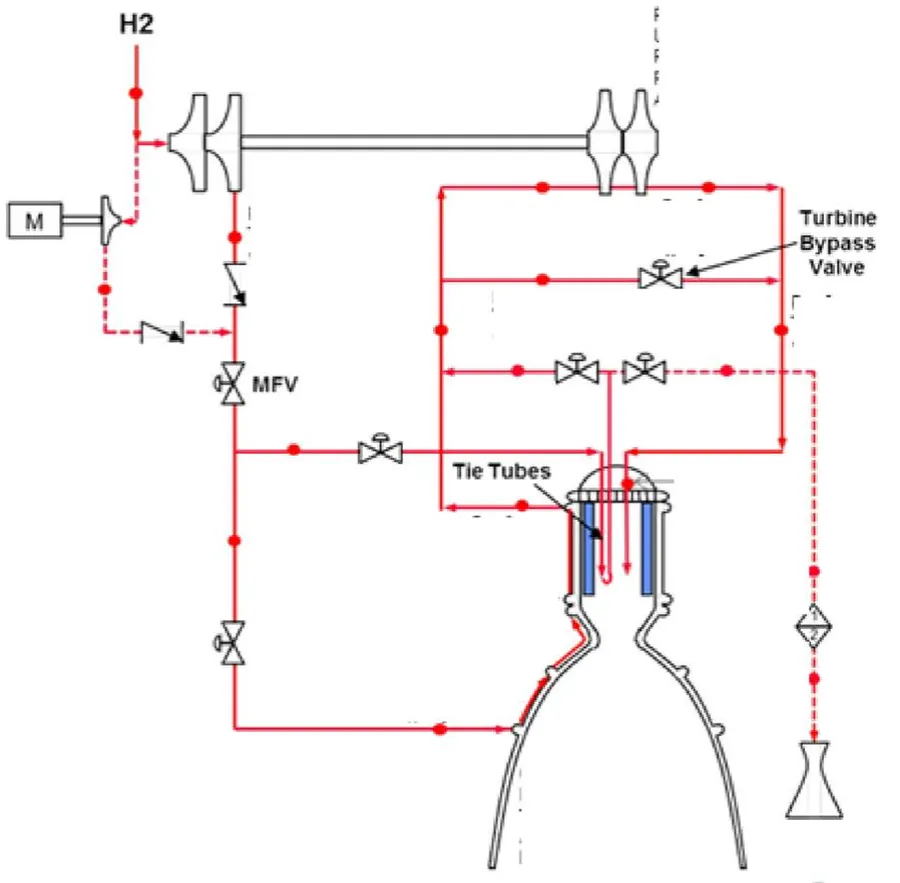
Figure 1: A basic NTP engine cycle. In this cycle H2 is pressurised through a turbopump before being flowed through regenerative cooling channels in the engine and into the reactor core. Most of the superheated H2 from the reactor core is then expelled through the nozzle to generate thrust, with some of the H2 being tapped-off to flow through a turbine to power the pump.
The advantage of NTP over conventional chemical propulsion is that it is more efficient and less mechanically complex. To explain the difference at a high level– an NTP engine propellant is pressurized, flown through the reactor and expelled to create thrust (see Figure 1) with no chemical reaction required to take place. A conventional chemical rocket requires both a fuel and an oxidizer to be pressurized at the right ratios (usually through the use of preburner driven turbopumps), mixed through injection into a combustion chamber, burnt, and expelled to create thrust (see Figure 2). Chemical engines are more unstable, have a lower specific impulse, and have a more complex engine cycle.
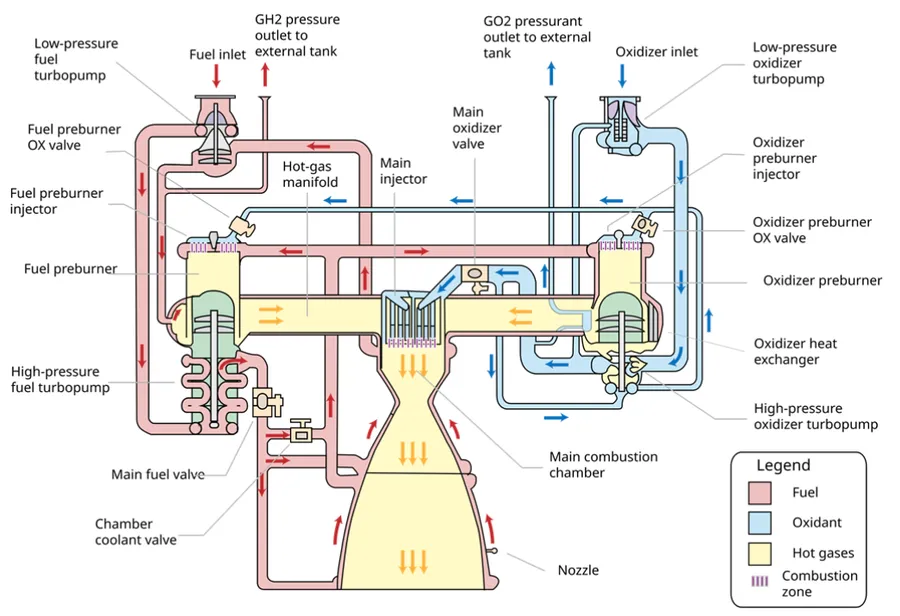
Figure 2: This is the engine cycle of the RS-25 engine used on the space shuttles. Here there are fluids at play, the H2 fuel and the O2 oxidizer. Both are presized by turbopumps driven by fuel rich preburners (the exhaust of the preburner powering the turbine is mostly unreacted H2). The H2 after being pressurized is flown through cooling channels throughout the engine. The O2 and H2 meet in the main injector and react in the main combustion chamber creating combustion products (moistly H2O) that are the propellant for the engine expelled through the nozzle to generate thrust.
Now this is not to say that NTP is without its issues, it uses a nuclear reactor and that has plenty of complexity and added considerations. There are reasons it is still a technology that has not been used in actual missions and has only been demonstrated in ground testing from corrosion of the fuel to thermal management of the engine.
History of NERVA
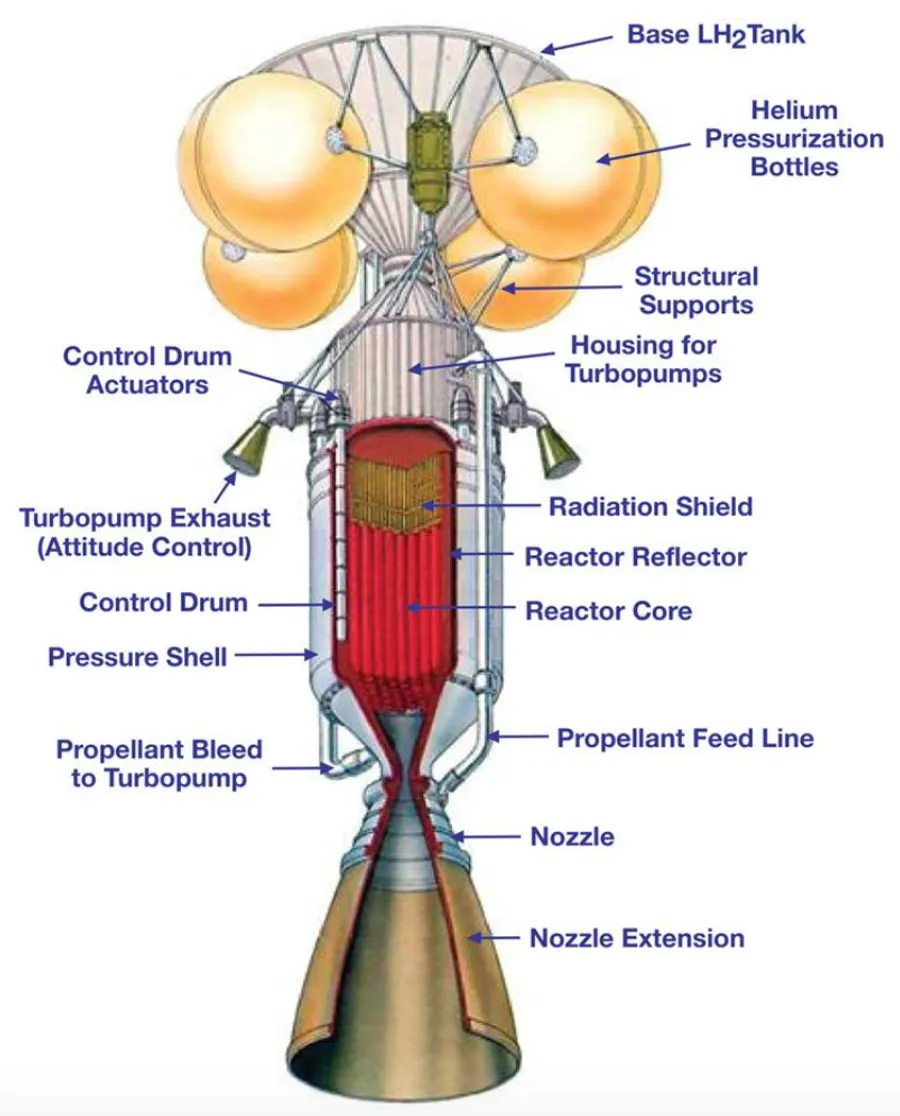
Figure 4: Architecture of the NERVA flight engine configuration.
The United State’s long history with nuclear rocket propulsion began in 1955 and was best encapsulated by the NERVA (Nuclear Engine for Rocket for Rocket Vehicle Application) program of the 1960s. NERVA's core objective can be distilled down to the establishment of a technological base for future in-space NTP applications. Interest then, as now, in near earth space exploration/development (Moon, Mars, etc.) were limited in options for propulsion under parameters of cost and travel time and NTP was considered a viable option early on. NERVA was a joint Atomic Energy Commission (AEO) and National Aeronautics and Space Administration (NASA) program tasked with the development of reactor, rocket, and reactor fuel technologies to demonstrate their feasibility for in-space use with ground based testing. In-space testing was originally considered but due to nuclear reactor technology being in its infancy, a fully ground based approach was utilized during the duration of the NERVA program. Despite this, the program was immensely successful even though an in-space application failed to be pursued in the subsequent decades.
NERVA’s accomplishments can be categorized into the following:
- The exploration and narrowing down of potential engine cycles and reactor core types that are feasible and practicable.
- Development of reactor fuels and corrosion resistant coatings to allow for engine thrust and run times to meet performance requirements for in space applications.
- Successfully demonstrated working development engine culminating with the XE dev engine demonstrating self-restart capabilities and the NRX-A6 dev engine running for one hour continuously at operating temperatures in excess of 2200 K, with extrapolated engine life times of 2-3 hours.
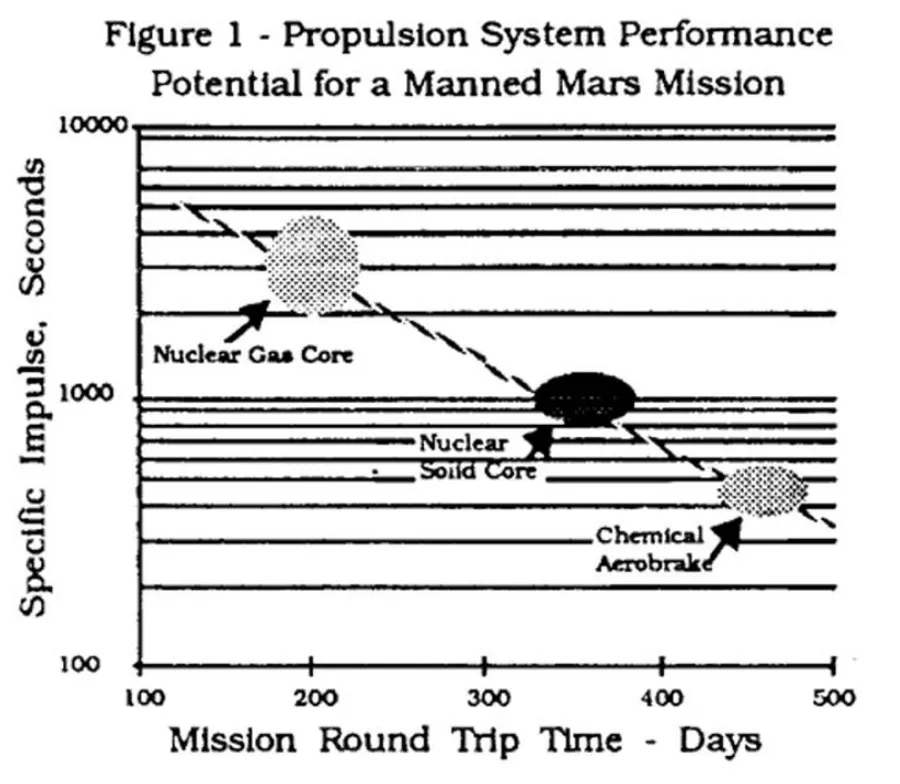
Figure 5: Plot of ISP of various propulsion options for a mission to mars. [2]
There are two main reactor core types that were investigated for a NTP engine, solid core and gas core. The latter showed significantly higher predicted ISP gains over chemical than the solid core predictions. The issue with gas core reactors is the temperatures produced are so high, the extreme temperature being the source of the ISP gain, that material property constraints made them infeasible for the desired applications if not impossible with the material properties of the time. Issues also arose as the effects of buoyancy on the gaseous uranium fuel made the only feasible testing environment in space. For NERVA, as is the case to this day, Solid core reactor designs were determined to be the only practicable solution with theoretical ISPs of 800s - 1000s (see Figure 5).
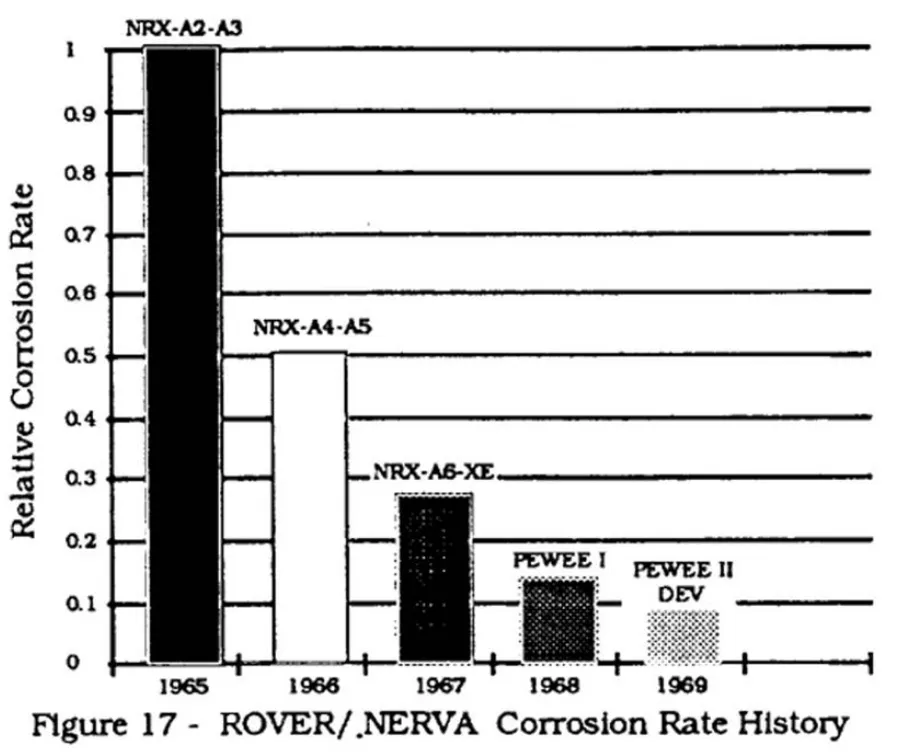
Figure 6: Plot showing the improvements in corrosion resistance throughout the NERVA program. [2]
The composition and construction of the reactor fuel elements are the largest constraint on two critical factors of an engine's performance, max operating temperature and corrosion. In a nuclear rocket engine these are coupled parameters. The higher the operating temperature of the core, the faster fuel elements or other components corrode and the more corrosion resistance the higher the max operating temperature can be. The performance parameters directly affected by this are thrust (a function of core temperature at a given flow rate) and engine life (a function of the corrosion of the engine). A conclusion from the NERVA program (as is still the case today) is that the optimal propellent/coolant going through the core be hydrogen (H2) and the uranium fuel elements themselves be a carbon composite to withstand the reactor core temperatures. Superheated hydrogen is very reactive with carbon and uncoated fuel elements decompose quickly. The NERVA program developed Niobium and Zirconium carbide coatings that dramatically reduced the rate of corrosion of elements and massively extended run times and increased core operating temperatures (see Figures 6 & 7).The advancements in composite reactor fuels by NERVA serve the foundation of reactor fuel development to this day.
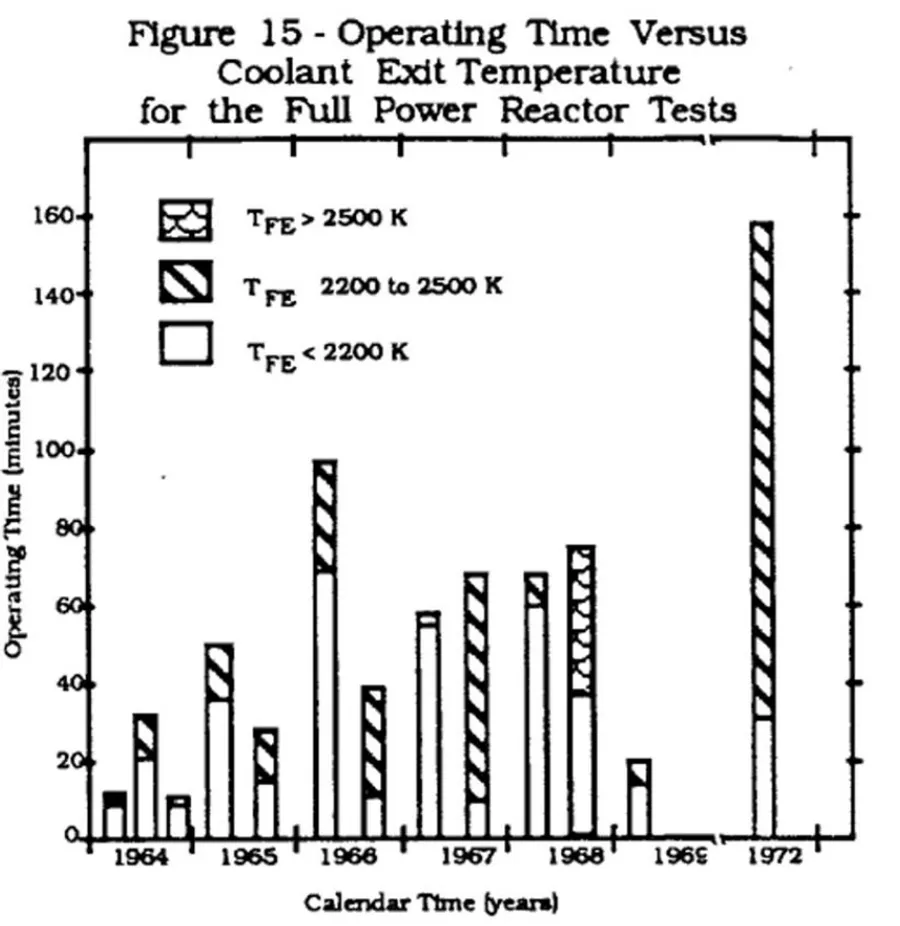
Figure 7: Plot shows that as NERVA progressed they were able to operate the engines longer and hotter. [2]
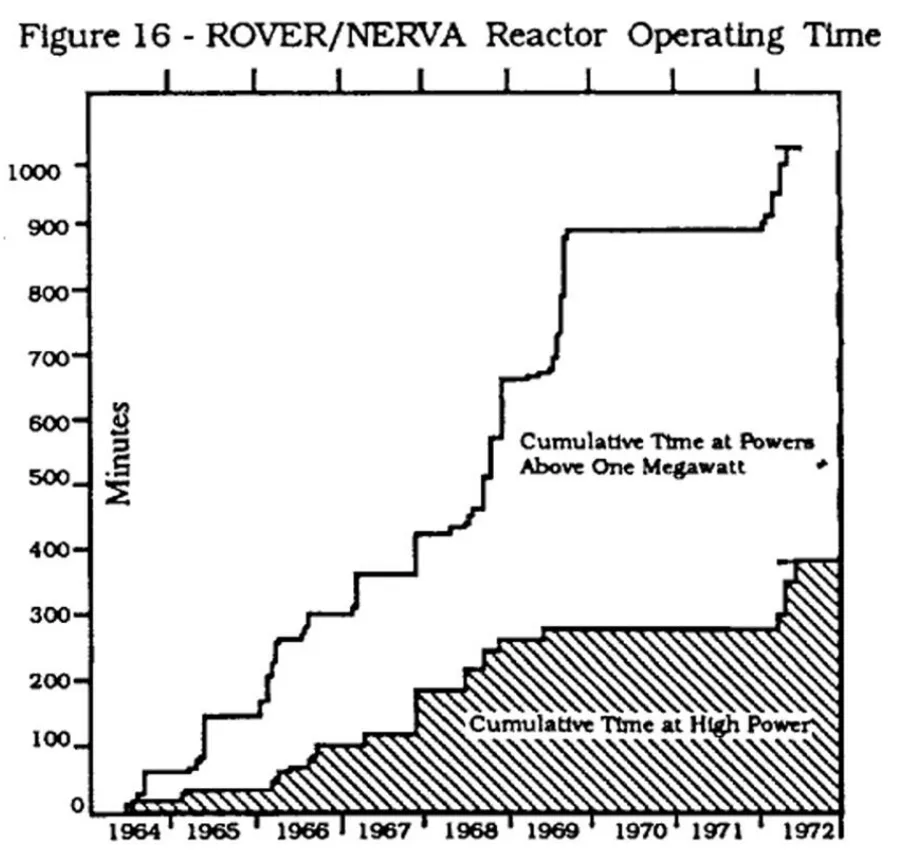
Figure 8: A plot breaking down the cumulative dev engine operating time throughout NERVA. They are split into two categories, Time running above the mission operational requirement of one megawatt, and the other being at high power. [2]
Engine performance grew substantially throughout the duration of NERVA with the NRX-A6 dev engine achieving an hour-long continuous run in 1967 and the XE dev engine achieving 28 self-operated restarts within its 115 minutes of operation. NERVA successfully built a technological base for the required components and operation of a nuclear rocket engine and successfully demonstrated the operation and improvements with their ground based dev engine tests with around 1500 minutes cumulatively of test operation throughout the program (see Figure 8). NERVA also boasted a stellar safety record for the program with no reactor related injuries and the most serious throughout the program being a hydrogen explosion causing two cases of foot and ear drum injuries. NERVA achieved its goals and set the stage for future in-space NTP demonstrators and applications.
Resurgence Of Interest
In 2020, interest in NTP once again reignited amid proposals and initiatives for manned and unmanned missions to Mars and the Moon. That year the Space Nuclear Propulsion Technologies Committee convened to address the viable options for propulsion methods that had the potential to substantially reduce trip time. For space missions, particularly manned missions, longer trip times increase the complexity of the mission and material requirements. In the case of a manned Mars mission, increased trip time means increased radiation exposure, increased life support capacity, increased time in microgravity, and a myriad of other baggage associated with extended times in-space. Means of propulsion to shorten this time increases the safety and health of the astronauts, lowers the cost of the mission, and decreases the strain on systems due to shorter operation time. [9]
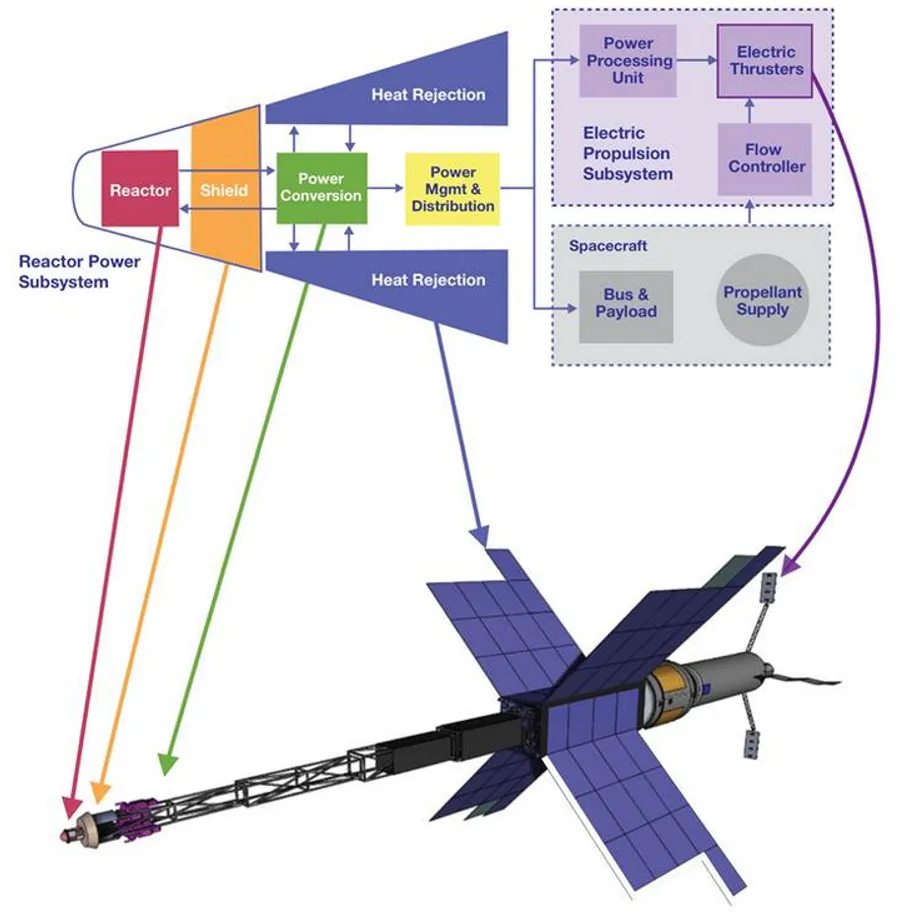
Figure 9: A NEP system uses a nuclear reactor to generate electricity. That is used to power means of electric propulsion, for example a Hal-effect thruster. This is done by ionizing a gas to accelerate it to high velocities to provide thrust. The thrust provided is extremely low, but the thrusters themselves are extremely efficient with ISPs in the range of 2000-7000 s. [9]
A study published in the National Academies Press in 2021 [9] investigated the feasibility of NTP and Nuclear Electric Propulsion (NEP) for a manned mission to Mars with a target 2039 launch date. A NEP system (see Figure 9), while promising, was deemed unlikely to be developed quickly enough to meet the proposed deadline. NTP, while needing development in key areas, was deemed a feasible option to be developed in the time frame and meet the performance requirements specified in the study. Key NTP performance requirements for a Mars capable mission were:
- An ISP of at least 900s
- Net thrust off all engines on vehicle of 100,000 lbf
- Capable of 4 hours of run time
- Reactor thermal power of 500 Mega Watts
- The being capable of heating the propellent to 2700 K
- Liquid H2 (LH2) Propellent being stored at 20 K
The study found that an aggressive development cycle using both in-space subscale testing and ground based full scale testing would be required to develop the technology for a 2039 manned Mars mission. NERVA proved the technology as feasible and obtainable. And the program provided a sufficient roadmap to reestablish both in a reasonable timeline using improved reactor and materials developments in the intervening years.
Draco
In 2023 the Defense Advanced Research Agency (DARPA) expanded their Demonstration Rocket for Agile Cislunar Operations (DRACO) program to a joint venture with NASA. Lockheed Martin and BWX Technologies (BWXT) were contracted out to design and build a NTP demonstrator for 2027 (BWXT would design and build the reactor while Lockheed Martin would design and build the turbomachinery, propulsion systems, and demonstrator vehicle) [6]. DARPA and NASA both share a need for NTP capabilities for orbital, cis-lunar, and Mars transit applications. The Department of Defense (DoD) has stated the need for the ability to more dynamically position and maneuver their in space assets. NASA interest in cis-lunar transit and Mars missions would benefit from the decreased trip times and simpler propellent requirements NTP can provide [3].
Key to the new thrust in NTP development under DRACO has been the use of high-assay low-enriched uranium (HALEU) in place of the high enriched uranium (HEU) that was used in NERVA. HALEU is a fuel that is enriched to between 5% and 19.75% uranium-235. It is a newly emerging fuel type for commercial reactor use as it gives the benefit of greater reactor life and less waste than low enriched uranium (LEU), which is enriched to less than 5%, while being more safe for commercial use than HEU. HALEU also benefits from the ability to downblend existing HEU stockpiles increasing the speed of HALEU production [7]. Since at least 2020 HALEU has been earmarked as the fuel of choice for NTP development going forward [9].
DRACO’s development was plagued with delays and program re-scoping. As of 2024 and 2025 the design parameters for the demonstrator has been downgraded from a LH2 propellent pressurized by a turbopump to a pressure-fed Helium demonstrator [3]. This stems from Lockheed Martin's inability to create LH2 storage and turbomachinery for the demonstrator and downgrading mission parameters to meet their abilities. DRACO was meant to demonstrate to the DoD and NASA the use of NTP technologies that would be used for military and civilian applications. A pressure fed Helium NTP is incapable of achieving the necessary ISP, thrust, burn duration, and restart capabilities that is required for cis-lunar and Mars transit applications. Currently this descoping of capabilities has put into question the viability of the program and Lockheed Martin's ability to deliver a demonstrator that can meet keep design parameters, including LH2 propellant and a turbopump.This lowering of demonstrator capabilities and increased cost lead to DARPA cancelling DRACO in June of this year. They cite increased launch costs, lower than expected efficiency gains, and more precarious funding from congress as the basis for the cancellation [10].
Present State and Future Possibilities
Currently the future of NTP and in-space nuclear in general is uncertain. Turmoil in the political landscape has thrown most things on their head as across the board priorities and funding in American space development are in constant flux as a result [11]. This makes predictions of what the future of in-space nuclear programs may entail difficult and unreliable. But there are some clues on where things might be going. To counter China’s April announcement of a lunar nuclear power plant initiative the United States announced their own initiative to do the same in August [12]. This clear and present competition in development might act as the stabilizing force in-space nuclear needs to get off the ground. NTP and NEP are both still on the table in government and commercial plans [10]. NEP in particular could potentially see a second wind as the longer development times can now be reassessed in the collapse of the DRACO program and advancements in reactor technology from the current lunar reactor initiative. NTP also has hope on its horizon. While Lockheed Martin is left in the lurch, BWXT has taken its developments in reactor technology from DRACO and are pivoting towards the initiatives for lunar nuclear power plants. While not NTP this will serve as a continuance of development of in-space reactors which can be used in future NTP and NEP programs.
Governments and private industry have made clear their intent to establish a permanent presence on the Moon, venture to Mars, and expand in-space infrastructure. Meeting these objectives will require propulsion systems that are not only more efficient than chemical rockets but also scalable to sustained operations beyond Earth orbit. In-space nuclear propulsion–through both NTP and NEP–offers a viable pathway to reduced mission costs, shortened travel times, and the ability to travel further into space than previously thought possible. If these technologies can continue to progress, they will not only enhance strategic freedom of action for both government and private entities, but serve as the cornerstone for humanity's journey into the stars. Ultimately the future of our progress rests in the ability of our policy makers to understand the problems they are trying to solve; they are dependent on the information communicated to them. As Admiral Rickover closed in his famous memo:
“Yet it is incumbent on those in high places to make wise decisions, and it is reasonable and important that the public be correctly informed. It is consequently incumbent on all of us to state the facts as forthrightly as possible.” [1]
Sources
[1] - Admiral Rickover’s Paper Reactor memo
https://whatisnuclear.com/rickover.html
[2] - An Historical Perspective of the NERVA Nuclear Rocket Engine Technology Program, Robbins
http://large.stanford.edu/courses/2011/ph240/nguyen1/docs/19910017902_1991017902.pdf
[3] - DARPA-SN-25-21
[5] - https://www.washingtonpost.com/technology/2023/07/26/nuclear-rocket-contract-nasa-darpa/
[6] - https://www.darpa.mil/news/2023/draco-experimental-vehicle
[7] - https://www.energy.gov/ne/articles/what-high-assay-low-enriched-uranium-haleu
[8] - Rocket Propulsion Elements - 9th edition, Sutton & Biblarz
[9] - Space Nuclear Propulsion for Human Mars Exploration, , National Academies Press
https://nap.nationalacademies.org/catalog/25977/space-nuclear-propulsion-for-human-mars-exploration
[10] - https://breakingdefense.com/2025/06/darpas-draco-nuclear-propulsion-project-roars-no-more/